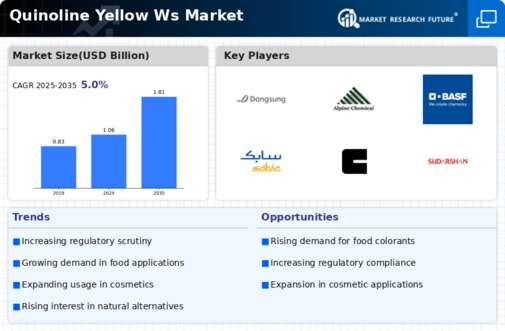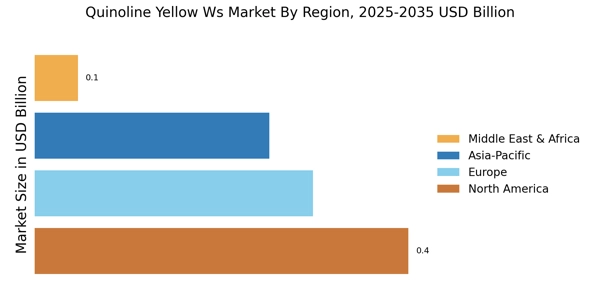Increased Regulatory Scrutiny
The Quinoline Yellow Ws Market is currently navigating a landscape of increased regulatory scrutiny regarding food additives. Regulatory bodies are implementing stricter guidelines and safety assessments for color additives, which could impact market dynamics. While this may pose challenges for manufacturers, it also presents opportunities for those who can demonstrate compliance and safety. The demand for transparency and safety in food products is growing, leading to a potential shift towards more natural alternatives. However, Quinoline Yellow remains a popular choice due to its established safety profile and effectiveness. As regulations evolve, the Quinoline Yellow Ws Market may need to adapt, ensuring that products meet the new standards while maintaining consumer trust.
Growing Awareness of Food Labeling
The Quinoline Yellow Ws Market is experiencing a shift driven by growing consumer awareness regarding food labeling and ingredient transparency. As consumers become more informed about the contents of their food, there is a rising demand for clear labeling of color additives. This trend is prompting manufacturers to be more transparent about their use of Quinoline Yellow and other additives. Market data suggests that products with clear and informative labeling are more likely to attract health-conscious consumers. Consequently, this awareness is likely to influence purchasing decisions, thereby impacting the demand for Quinoline Yellow in various food products. The Quinoline Yellow Ws Market must adapt to these changing consumer preferences to maintain competitiveness.
Technological Innovations in Production
Technological advancements in the production of color additives are significantly influencing the Quinoline Yellow Ws Market. Innovations in manufacturing processes, such as improved extraction techniques and quality control measures, are enhancing the efficiency and safety of Quinoline Yellow production. These advancements not only reduce production costs but also improve the overall quality of the final product. Furthermore, the integration of automation and data analytics in production facilities is streamlining operations, allowing for better scalability and consistency. As manufacturers adopt these technologies, the Quinoline Yellow Ws Market is likely to benefit from increased supply and reduced prices, making it a more attractive option for various applications.
Expansion in Personal Care and Cosmetics
The personal care and cosmetics sector is witnessing a notable expansion, which serves as a crucial driver for the Quinoline Yellow Ws Market. The demand for vibrant colors in cosmetics, such as lipsticks, eyeshadows, and skincare products, is on the rise. Quinoline Yellow is often utilized for its stability and bright coloration, appealing to consumers seeking high-quality cosmetic products. Market analysis indicates that the cosmetics industry is projected to grow at a compound annual growth rate of around 5% over the next few years. This growth is likely to bolster the demand for color additives, including Quinoline Yellow, thereby enhancing the market dynamics within the Quinoline Yellow Ws Market.
Rising Demand in Food and Beverage Sector
The increasing demand for vibrant and visually appealing food products is a primary driver in the Quinoline Yellow Ws Market. As consumers become more discerning about aesthetics in their food choices, manufacturers are compelled to incorporate color additives that enhance visual appeal. Quinoline Yellow, known for its bright yellow hue, is particularly favored in beverages, confectionery, and dairy products. According to recent data, the food and beverage sector accounts for a substantial share of the color additives market, with projections indicating a growth rate of approximately 4.5% annually. This trend suggests that the Quinoline Yellow Ws Market is likely to experience significant growth as manufacturers seek to meet consumer preferences for colorful and attractive food items.


















Leave a Comment